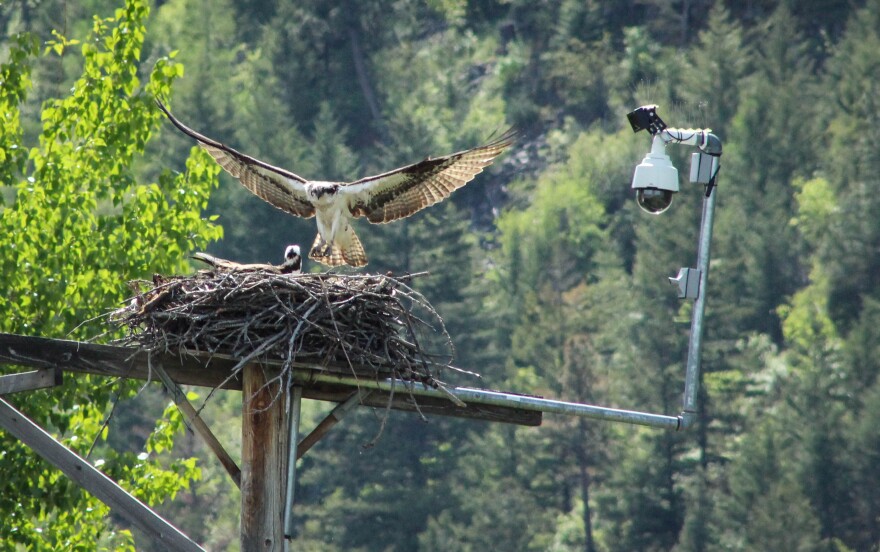In a nest high atop a wooden pole under a bluebird sky, an osprey called over and over. The Clark Fork river rushed by a few dozen feet away, and ornithologist Erick Greene stood in the nearly empty parking lot beneath the nest.
“When she calls like that, that call usually means she sees her mate,” Greene said.
He lifts his binoculars and peers downriver.
“Oh, here he comes,” Greene said. “Yep, see him right here?”
Sure enough, a second osprey swooped over to the nest clutching a small fish. He handed off the catch to his mate. Greene smiled and lowered his binoculars.
“Not bad, huh?”
Greene “speaks” osprey. He’s studied the birds for more than three decades and visits this nest nearly every day. And, he’s far from the only one watching.
“Iris has kind of gone viral,” Greene said. “She’s a superstar.”
“Iris” is the name of the osprey that’s called this nest home for more than two decades. She got her name from the distinctive speckles in her eyes.
Since 2013, a small, black orb hanging over her nest has live-streamed every moment to social media followers worldwide. Her fanbase has swelled to more than 20,000 people. Greene said they’ve watched Iris weather many setbacks through the years.
“Different males, you know — ups and downs, losing babies, losing eggs,” he said.
The two eggs this year are a huge achievement. Thanks to a reliable new mate, Iris has the chance to raise chicks for the first time in five years. Greene and others around the world have been watching closely to see if those eggs hatch.
Iris’ fans say they’re drawn to her story of survival. She’s become one of the oldest known ospreys in the world while feeding from one of the country’s largest Superfund complexes.
More than 100 miles of the Clark Fork River is contaminated with heavy metals and chemicals washed away from a century of mining, milling and smelting. Back in 2006, Greene and other University of Montana scientists realized raptors living along the river could play a crucial scientific role.
“They’re sort of like a canary in a coal mine, right?” Greene said. “They’re telling us about the health of the river.”

Tiny particles of mining waste travel up the food chain in the river ecosystem, from bottom-feeders to fish and, finally, to ospreys. Local scientists with the Montana Osprey Project keep tabs on the Clark Fork’s pollution — and cleanup efforts — by taking blood samples from osprey chicks.
“We’re getting this really amazing view of what it takes to be, in this case, an osprey raising chicks in a sort of challenging environment,” Greene said.
While scientists for years have told humans not to eat fish from the Clark Fork near Missoula, ospreys don’t follow that rule. Greene said Iris’ longevity is a testament to her strength — and to the river’s ongoing recovery.
Iris is about 28 years old.
“Most ospreys don’t live probably beyond seven, eight years,” Greene said. “So, she’s pretty special that way.”
Iris has out-lived at least three mates, hail storms and floods, and a five-year stretch without a reliable partner.
Many of the ups and downs of her life have been documented by a woman who lives more than 2,000 miles away. Sharon Leigh Miles is a volunteer camera operator for Cornell College’s Bird Cam program.
“That’s what brings me the most joy, is to be able to teach people,” Miles said.
From her home in Lexington, S.C., she and other volunteers feed Iris’ social media followers a 24-hour stream after she migrates back to Missoula.
“When Iris returns, my husband says, ‘I’ll see you in the fall,’” Miles said, laughing. “Literally, every year!”
Miles is part of the Montana Osprey Project, too. Her role is to make sure osprey-watchers have the tools to become citizen scientists themselves.

Miles has always been drawn to Iris’ resilience as a mother. She recalled a moment in 2018 that captured that spirit. Iris’ former mate Louis was struggling to catch fish for Iris and their three chicks.
“We lost two of them; there was one left,” Miles said.
Then, she watched as Iris left the nest, leaving her remaining chick unguarded.
“She was gone a long time, and I was petrified,” Miles recalled.
Miles knew a raven could come by at any minute and carry the last chick away. Long minutes passed, until:
“Iris came back with the biggest fish you have ever seen,” she said. “That’s my memory of Iris. She did what she had to do, and that’s a great mom.”
This year, Iris has the chance to be a great mom once again. Her first egg hatched in the early hours of June 12. She and her new mate will spend the rest of the summer feeding, defending, and teaching until migration season arrives once again.
Click on the video above to view the Hellgate Osprey Cam livestream.


